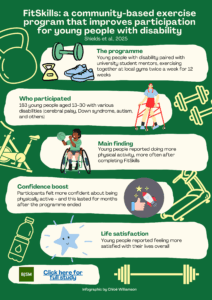Why is this study important?
Participating in physical activity has health benefits for young people with disability, but many participate in less physical activity than their peers without disability (Carlon et al 2013). Participation is ‘involvement in a life situation’ and has two components: attendance (being there) and involvement (the experience of participation). Essentially, participation means both showing up to activities and feeling engaged while doing them. Young people with disability describe many barriers that prevent their participation in physical activity such as a lack of suitable programmes and having no one to exercise with (Mahy et al 2010). Although young people with disability prefer to exercise at community venues (Hassett et al 2021) with their peers (Shields et al 2019), exercise studies are usually done in laboratories or clinics and supervised by specialists. Previous studies also focus on changing the behaviours of young people with disability, even though the main reasons for their low participation in physical are because of the environment (McKenzie et al 2021).
We developed a model of exercise called FitSkills. It involves matching a young person with disability with a volunteer university student mentor enrolled in a health-related degree program, and the pair exercise together at their local community gymnasium, twice a week for 12 weeks. Our previous research shows that FitSkills is feasible, safe and scalable in real-world settings (Shields et al 2022). There is also some evidence it has short-term positive effects on muscle strength and how far they can walk in 6 minutes (Shields et al 2019). However, we did not know if FitSkills improved young people with disability’s participation in physical activity.
How did the study go about this?
We did a stepped wedge cluster randomised trial. In this type of trial we gradually introduce a program across different gyms. Our trial involved 163 young people with (any) disability aged between 13 and 30 years of age (average age was 19). Young people with cerebral palsy (36%), Down syndrome (25%) and autism (18%) enrolled, many who also had intellectual disability (47%), mental health (33%) and communication difficulties (48%). We compared FitSkills with usual activities. We introduced FitSkills at groups of 2 to 3 gyms (11 sites total) in a random order every 3 months. Participants and mentors exercised together at a gym close to where they lived. They completed an exercise consultation before they started FitSkills so their exercise program could be adapted to their goals and preferences. We measured outcomes related to participation (attendance and involvement), health-related quality of life, physical activity levels, how far a person could walk in 6 minutes attitudes to exercise and well-being, 8 times every 3 months. We analysed immediate (after 12 weeks) and intermediate (after up to 15 months) effects of FitSkills. One-hundred and twenty-three young people and 123 student mentors completed FitSkills.
What did the study find?
Immediately after FitSkills young people with disability reported taking part in more physical activities, more often. They also reported an increase in their confidence to exercise. An unexpected finding was a small decrease in their walking capacity immediately after FitSkills but this was not sustained in the intermediate term.
In the intermediate term, the changes in the number of physical activities the young people with disability reported doing and their confidence to exercise were sustained. They also reported a small positive change in their life satisfaction.
We found no change in participation involvement, health-related quality of life, exercise preferences, perceived barriers to or benefits from exercise or physical activity levels measuring using an accelerometer (a device that measures movement).
What are the key take-home points?
A 12-week community-based student-mentored physical activity programme (FitSkills) was effective in increasing participation attendance, and in improving confidence to exercise and life satisfaction among young people with disability.
Our study builds on the evidence by supporting the use of short-term peer-mentored community programmes as a means of supporting young people to exercise.
References
Carlon SL, Taylor NF, Dodd KJ, et al. Differences in habitual physical activity levels of young people with cerebral palsy and their typically developing peers: a systematic review. Disabil Rehabil 2013;35:647–55.
Hassett L, Shields N, Cole J, et al. Comparisons of leisure-time physical activity participation by adults with and without a disability: results of an Australian cross-sectional national survey. BMJ Open Sport Exerc Med 2021;7:e000991.
Mahy J, Shields N, Taylor NF, Dodd KJ. Identifying facilitators and barriers to physical activity for adults with Down syndrome. Journal of Intellectual Disability Research. 2010 Sep;54(9):795-805.
McKenzie G, Willis C, Shields N. Barriers and facilitators of physical activity participation for young people and adults with childhood‐onset physical disability: a mixed methods systematic review. Develop Med Child Neuro 2021;63:914–24.
Shields N, van den Bos R, Buhlert-Smith K, et al. A community-based exercise program to increase participation in physical activities among youth with disability: a feasibility study. Disabil Rehabil 2019;41:1152–9.
Shields N, Willis C, Imms C, et al. Feasibility of scaling-up a community-based exercise program for young people with disability. Disabil Rehabil 2022;44:1669–81.
